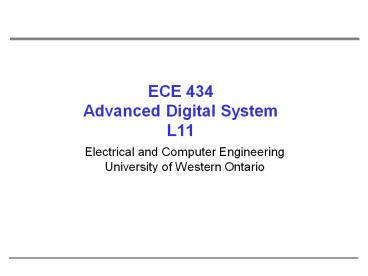ECE 434 Advanced Digital System L11 - PowerPoint PPT Presentation
Title:
ECE 434 Advanced Digital System L11
Description:
Serial Adder with Accumulator. Serial-Parallel Multiplier. 10/18/09. 3 ... Serial Adder with Accumulator. 10/18/09. 13. State Graphs for Control Networks ... – PowerPoint PPT presentation
Number of Views:244
Avg rating:3.0/5.0
Title: ECE 434 Advanced Digital System L11
1
ECE 434Advanced Digital SystemL11
- Electrical and Computer EngineeringUniversity of
Western Ontario
2
Outline
- Review VHDL Functions, Procedures, Packages
Libraries - Networks for Arithmetic Operations
- Serial Adder with Accumulator
- Serial-Parallel Multiplier
3
Review VHDL Functions
- Functions execute a sequential algorithm and
return a single value to calling program
- A 10010101
- General form
4
Review For Loops
5
Review VHDL Procedures
- Facilitate decomposition of VHDL code into
modules - Procedures can return any number of values using
output parameters
- General form
procedure procedure_name (formal-parameter-list)
is declarations begin Sequential-statements en
d procedure_name
procedure_name (actual-parameter-list)
6
Review Packages and Libraries
- Provide a convenient way of referencing
frequently used functions and components
- Package declaration
- Package body optional
7
Review VHDL Model for a 74163 Counter
- 74163 4-bit fully synchronous binary counter
- Counter operations
- Generate a Cout in state 15 if T1
- Cout Q3Q2Q1Q0T
8
Review VHDL Model for a 74163 Counter
9
Cascaded Counters
10
Cascaded Counters (contd)
11
Networks for Arithmetic Operations
- Case Study Serial Adder with Accumulator
12
Networks for Arithmetic Operations
- Serial Adder with Accumulator
13
State Graphs for Control Networks
- Use variable names instead of 0s and 1s
- E.g., XiXj/ZpZq
- if Xi and Xj inputs are 1, the outputs Zp and Zq
are 1 (all other outputs are 0s) - E.g., X X1X2X3X4, Z Z1Z2Z3Z4
- X1X4/Z2Z3 1 - - 0 / 0 1 1 0
14
Constraints on Input Labels
- Assume I input expression gt we traverse the
arc when I1
Assures that at most one input label can be 1 at
any given time
Assures that at least one input label will be 1
at any given time
1 2 Exactly one label will be 1 gt the next
state will be uniquely defined for every input
combination
15
Constraints on Input Labels (contd)
16
Networks for Arithmetic Operations
- Case Study Serial Parallel Multiplier
Note we use unsigned binary numbers
17
Block Diagram of a Binary Multiplier
Ad add signal // adder outputs are stored into
the ACC Sh shift signal // shift all 9 bits to
right Ld load signal // load multiplier into
the 4 lower bits of the ACC and clear the upper 5
bits
18
Multiplication Example
19
State Graph for Binary Multiplier
20
Behavioral VHDL Model
21
Behavioral VHDL Model (contd)
22
Multiplier Control with Counter
- Current design control part generates the
control signals (shift/add) and counts the number
of steps - If the number of bits is large (e.g., 64),the
control network can be divided intoa counter and
a shift/add control
23
Multiplier Control with Counter (contd)
Counter generates a completion signal K that
stops the multiplier after the proper number of
shiftshave been completed
24
Multiplier Control with Counter (contd)
25
Operation of a Multiplier Using Counter
26
Array Multiplier
27
Array Multiplier (contd)
28
Multiplication of Signed Binary Numbers
- How to multiply signed binary numbers?
- Procedure
- Complement the multiplier if negative
- Complement the multiplicand if negative
- Multiply two positive binary numbers
- Complement the product if it should be negative
- Simple but requires more hardware and timethan
other available methods
29
Multiplication of Signed Binary Numbers
- Four cases
- Multiplicand is positive, multiplier is positive
- Multiplicand is negative, multiplier is positive
- Multiplicand is positive, multiplier is negative
- Multiplier is negative, multiplicand is negative
30
To Do
- Read chapters 4.1, 4.2, 4.3
- Do homework 3

